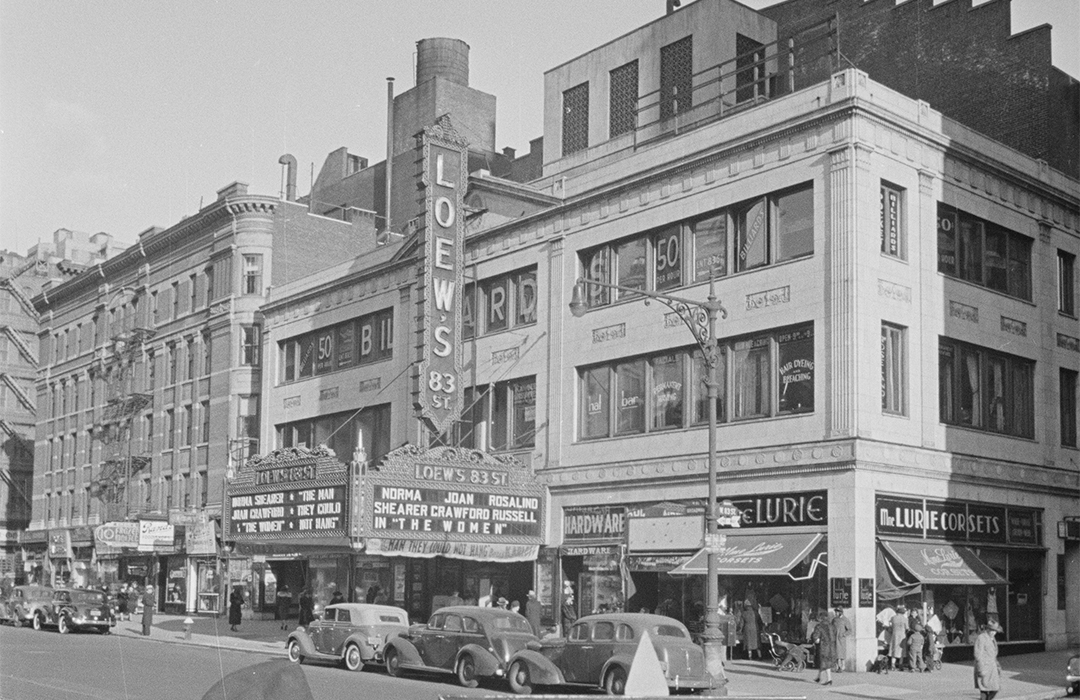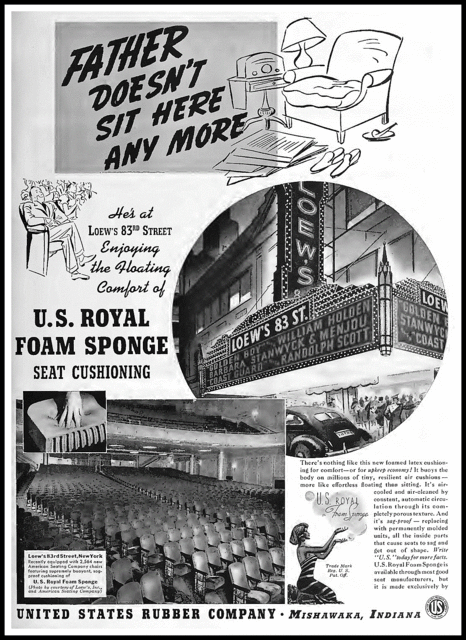
Loew’s 83rd Street Theatre
by Tom Miller
In December 1919, Marcus Loew purchased the buildings on the northeast corner of Broadway and 83rd Street as the site of a new motion picture theater. The Real Estate Record & Guide reported, “The total cost of the operation will amount approximately to $1,500,000. Thomas Lamb has been selected to draw plans for the theatre.” Thomas Lamb was one of America’s foremost theater architects, and Marcus Loew was the largest motion picture theater owner in New York. This would be his 32nd theater.
Decades earlier, the site had been part of the Patrick Brennan farm. (It was in the Brennan farmhouse in the summer of 1844 that Edgar Allen Poe wrote “The Raven.”) As excavation for the theater commenced, relics from the Brennan period were unearthed. On July 9, 1920, The Standard Union reported, “During the recent excavations, they ran across an old well which had been filled in for more than half a century, and curious and odd pieces of old Dutch china were found in it, which were dropped into the well, undoubtedly, when Broadway was still a farm.”
Completed in 1921, Thomas Lamb’s three-story, neo-Classical style structure featured double-height fluted pilasters on the upper levels, a frieze inspired by Greek temples, and a triangular pediment. An ornate marquee extended over the sidewalk on Broadway. There were shops on the ground floor, and store and office spaces above. The Evening World said succinctly, “The house is a fine one.”
Loew’s 83d Street Theatre opened on September 27, 1921, “with appropriate ceremonies, which included the presentation of motion picture stars and stage celebrities in person,” according to The Evening World. Pictures wrote, “The usual fanfare and flourish out of doors was conducted by the master of ballyhooshowism, Nila Grantlund, who presided over the sunlight arcs, and the news cameras that clicked the record of the celebrated arrivals.” The newspaper described the interior, saying, “Gold and blue is the color scheme in the lobby, foyer and auditorium proper…The house seats 3,000.”
the site had been part of the Patrick Brennan farm.
According to Pictures, throngs had begun forming on Broadway around 7:00. “The flashing arcs and the placing of the cameras held the crowds of strollers on Broadway,” said the article.” There to view the silent film The Affairs of Anstol were more than two dozen film and screen actors, including the cast of The Affairs of Anstol, Ben Turpin, Bee Palmer, Leo Carrillo, Johnnie Hines, Sallie Fields, Frank Fay, Adele Rowland, Ray Marble, and Doraldine.
Earlier silent film theaters hired in-house musicians to accompany the film. Loew’s 83d Street Theatre cut costs by installing an M. P. Möller pipe organ, which required just one musician. It would be upgraded in 1926 by another, larger Möller instrument.
In the decades before television kept families at home in their living rooms, motion picture theaters were a frequent outing. That meant that theaters needed to change the films often. On September 24, 1921, The Evening World announced that Loew’s 83rd Street Theatre “will have continuous showings of picture plays with three changes a week.” Only a week after its opening, however, it seemed that a policy change was in the works. Pictures reported on October 7, 1921, that the theater “may alter its policy, according to the views of picture men, to the change-daily.” That meant that a motion picture would run only for one day.
On the night of March 20, 1922, Thomas Delaney brought his 10-year-old son to the theater. He paid $1 for the two tickets, but once inside, realized there were no open seats. He returned to the lobby and complained to Harry Meek, the “doorkeeper.” It appears Delaney was vocal in his dissatisfaction because Meek and the manager, Elmer Homadieu, summoned a policeman to have Delaney removed. As it turned out, Delaney was an off-duty police sergeant. When the officer arrived, Delaney identified himself and had the theater employees arrested for disorderly conduct. Delaney was refunded his $1.
Among the second-floor tenants at the time of the incident was the jewelry store of John Knichthauser. On the afternoon of January 3, 1922, he and a clerk Jacob Kroll were behind the counter, while two jewelers were at work in the back. Three armed men walked into the store and ordered Knichtauser and Kroll to put up their hands. When Kroll was slower to respond than his boss, he was knocked to the floor unconscious. Hearing the commotion, one of the workmen “opened a window and shouted for help,” according to The Evening Telegram. “His cries alarmed the burglars, who seized a single diamond pin and fled.”
Crooks apparently watched the routine of assistant manager James H. Burt, who every afternoon took the previous day’s receipts to the Mechanics and Metals Bank on 86th Street and Broadway. He left the theater at 1:15 on February 9, 1925, with the porter, Francis Fetzer, who walked a few feet behind him. Burt had $4,800 in cash in his leather satchel—more than $74,000 in 2023 dollars. The New York Times reported, “As the two reached Eighty-fourth Street a dark red closed car suddenly turned the corner in front of Burt. Three men jumped out, seized him, and forced him into the car.” Fetzer was knocked to the pavement. When he got to his feet, the car was gone.
The thieves held Burt on the floor of the car, holding a pistol to his neck and warning him not to cry out. They drove to an apartment house at 169 West 78th Street where they left Burt in the hallway, telling him to stay there for five minutes. The bandits then drove off with the leather case of money. The New York Times explained, “According to the detectives, the hold-up men were apparently familiar with the day and hour when the theatre made its deposits at the bank.”
The thieves held Burt on the floor of the car, holding a pistol to his neck and warning him not to cry out.
The following year, crooks tried to rob the theater with less finesse. On March 29, 1926, The Standard Union reported, “Six young burglars, believed to be amateurs, early to-day blew the safe in Loew’s Eighty-third Street Theatre, but abandoned their quest for the day’s receipts of $5,000 when they were unable to force an inner door.” The would-be crooks had overpowered the two watchmen and tied them to theater seats. While they were unsuccessful at safe cracking, they were savvy enough that “At intervals one of [the watchmen] was released and taken to a telephone to make his hourly report.”
The building was renovated in 1957. The second floor now held a beauty parlor, a hand embroidery shop, a dentist office and various other offices. There were 35 small offices on the third floor.
By the mid-1960s Loew’s 83rd Street Theater ran double features to draw customers. The N. Y. & Brooklyn Daily reported in 1966, for instance, “Loew’s 83rd Street Theatre will feature a superb musical duo on Tuesday, August 30th. The films will be ‘The Pajama Game,’ in color, starring Doris Day and John Raitt; and ‘Damn Yankees, also in color, starring Gwen Verdon and Ray Walston.”
Three months earlier management had tried a clever way to draw crowds, as well—vintage musicals. The N. Y. & Brooklyn Daily reported, “Probably the most exciting news of the year for the lovers of great musical entertainment is the announcement by Loew’s 83rd Street Theatre of the presentation of a series of six double feature showings of the world’s greatest operettas starting Tuesday, May 17.” An example was the offering on June 7th of The Merry Widow, starring Jeanette MacDonald and Maurice Chevalier, and The Girl of the Golden West, starring Jeanette Macdonald and Nelson Eddy.
In 1975 the theater was converted to a triple-screen venue, and three years later, it became a quad. Two of the new venues could accommodate 500 patrons, and the other two could hold 550. But the end of the line for the venerable theater was on the horizon. Thomas Lamb’s handsome theater closed its doors for the last time on April 11, 1985. It was demolished for a 19-story mixed-use building.
Tom Miller is a social historian and blogger at daytoninmanhattan.blogspot.com
BUILDING DATABASE
Keep Exploring
Be a part of history!
Think Local First to support the business currently at 225 West 83rd Street aka 2300-2308 Broadway:



